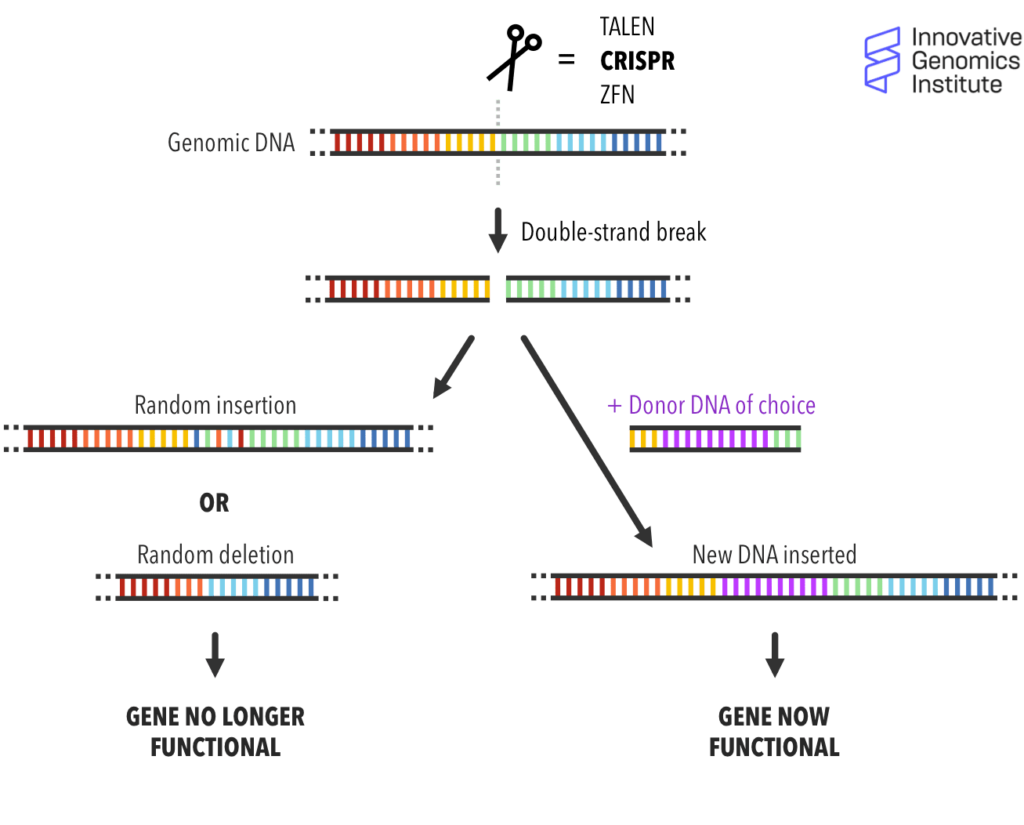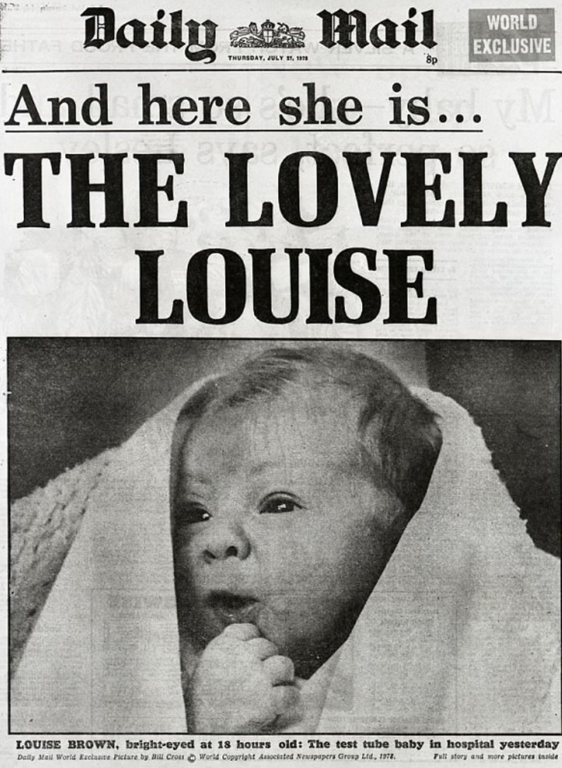We’re going to see gene-edited people within the next 20 years. You would think that we’re still far away from this surreal future, but technologically? I’d say that we’re already there. Now it’s only a question of how and when. Is it another “rogue scientist”? Medical tourism of gene therapy in Honduras?
Today, we’ll talk about my thoughts on the modern state of germline gene editing. Starting with what’s already being done in the clinic, we’ll move onto talk about a DNA cutter called CRISPR. Then, we’ll talk about what I think is going to happen in the next few decades, finishing off with what we can do about it as a society. Okay… let’s get into it!
What’s germline gene editing?
Germline gene editing is broadly the action of modifying the DNA of your eggs, sperm, or embryo. It’s distinct from the typical (somatic) gene editing in that germline editing creates permanent, heritable changes to someone’s DNA before they are born. It’s a hot research topic for the potential to save many babies from lethal genetic diseases, but it comes with the risk of creating permanent changes to that person’s body.
Making permanent changes to my body before I was even born to give consent? That’s a no for me. Unless, maybe, I had a lethal genetic disease that would’ve killed me otherwise…? Okay, fine.
Then I guess while you’re at it… why not add a few extra inches on me so I can finally say I’m 6ft on Hinge?
This is exactly the controversial allure of germline gene editing – after we perfect gene editing to fix genetic lethal disease, could we start using that technology to modify ourselves for traits like appearance or intelligence?
On the one hand, germline editing could allow us to create healthier, more viable embryo, giving us more control over diseases at the DNA level. On the other hand, perfecting gene editing could mean we could make appearance, intellect, and other qualitative traits a choice.
There’s no way that’s possible… right? Is it really okay for us to have those powers? How’s that allowed? Although the argument makes sense, depending on how you look at it, we’ve actually had these powers for a few decades now.
- Pre-natal screening
Most states in the US have a list of genetic diseases that they test for before the baby is born. It’s different by state, with states like New York having one of the most comprehensive test with over 60 different conditions on their disease panel.
The test can be done as early as during your first trimester, and all you need is a bit of blood. The purpose of the test is to make sure that the embryo doesn’t have a debilitating rare diseases like Congenital Hypothyroidism, but also test for diseases like Down Syndrome or Cystic Fibrosis that are not lethal but can have a significant impact on quality of life. Since these congenital diseases usually need immediate medical attention from the moment the baby is born, IVF has allowed parents to dramatically improve life expectancy for children born with genetic disease.
Prenatal screening therefore gives parents the resources to significantly improve the prognosis of their child, and, more profoundly, a choice to bring a sick child into this world or not.
So by extension, through this technology, we’ve given ourselves a new level of control over the genetic make-up of our kind. We’re now given the option to “sort out” for undesired traits through prenatal screening. In this case, even though we’re not directly editing the DNA, from a societal perspective we’ve already started to “choose” our own genes.
2. in vitro Fertilization (IVF)
IVF allows the egg-meets-sperm fertilization to happen outside of the body, on a petri dish. It allows many mothers to conceive and go through a natural pregnancy for many mothers who wouldn’t be able to conceive otherwise.
But IVF also allows many couples to prevent debilitating diseases from passing onto their offspring. For example, if there were a heterosexual couple trying to conceive, but they were both carriers for Cystic Fibrosis (CF). This means there is a 1 in 4 chance that your child will have CF if you conceive naturally. But with IVF, you can take the guess-work out completely. By fertilizing eggs on a petri dish, you can test each egg for CF, then implant the specific one without CF into the mother. And voila! Your child can live a full life without CF.

We’ve been doing IVF for over four decades now, and the diseases we can test with prenatal screening have also grown. Arguably, these technologies have already been allowing us to choose our offspring’s DNA, and it has very clearly helped thousands of people worldwide.
But now, there’s a new(ish) kid on the block that takes it a step further. While we’ve used prenatal screening and IVF for mostly gene selection, a new technology called CRISPR has unlocked a new drug class that can permanently fix dysfunctional genes through editing. In fact, this tool is now at the center of ethical and biological debate as we realized this would enable human germline editing.
From CRISPR “knock-in” to Human Germline Gene Editing

Over the past 10 years, the discovery of the DNA scissors, CRISPR/Cas9, has allowed us to cut the mammalian genome more accurately and efficiently than ever before. This is the stuff that won Jennifer Doudna and Emmanuelle Charpentier a Nobel Prize in 2020. It allows us Control + F and Control + X the human genome. Since its discovery in 2013, this little protein has gone through countless revision, optimization, patent battles, and even clinical trials. Just last month, we saw the first ever medicine using CRISPR be approved for sickle cell disease.
In just 11 years after the official discovery of CRISPR as a tool, we were able to turn it into a drug that can treat patients. That’s a miracle on it’s own, but CRISPR can do a lot more than treat disease. CRISPR’s a tool, and it’s one of the best we’ve ever found for cutting and pasting genes.

Known as “knock-in,” using CRISPR we can literally Control + F and Control + X the genome, where you can Find any DNA sequence you want, Cut it, and then, if you want, Paste or “knock in” your desired DNA sequence (Donor DNA) inside. And when you do this inside an (IVF) embryo when it’s still only 1-300 cells (<blastocyst), the cuts that you make with CRISPR stay there permanently, and those edited cells will duplicate while maintaining the cuts. Eventually, those cells grow into a full organism, with every single cell in the body having that exact edit you made. Using the same concept, you can also “knock out” certain genes by cutting out the gene that you don’t want in the cell.
There’s still a few improvements that have to be made, but the basic concept is the same. So if you wanted to do it in a mouse for example, all you need to do is follow a simple protocol that looks something like this:

Two-parts Cas9, two-parts oligo, one-part sgRNA, a little extra plasmid, mix it up in a tube, and voila! You got yourself a CRISPR knock-in mouse.
Obviously the actual protocol is a bit more complicated than that, but the concept is the same. It’s so fast, simple, and powerful, that CRISPR knock-in mice are now being commercially sold around the world, off-the-shelf, for laboratories specializing in disease research, drug discovery, and animal models.
But wait… we just treated someone with Sickle Cell disease using CRISPR, and we’ve gotten it to work really well in mice in just 11 years. If we can do all this, doesn’t that mean we can “knock in” and “knock out” any gene that we want in humans too? Yup, and that’s exactly the problem.
What’s next?
Mice to Humans is a big jump, so most (smart) people wouldn’t be taking the above CRISPR concoction, raid an egg bank, inject a few eggs with a CRISPR + knock-in construct, and IVF it into someone. Science, (un)fortunately, is extremely finnicky, and things rarely work in humans just because it worked in a petri dish or a mouse.
On top of that, we don’t know what kind of edits are linked to what other traits, or how they are passed down to future generations. What if I turned my future Asian nephew’s eyes green with CRISPR? Honestly, he’ll probably grow up to be perfectly healthy and honestly insanely popular in school. Maybe he’ll even be a model!
But what if green eye color specifically in Asians was somehow linked to color blindness? What if the reason Japanese people don’t get green eyes, is because throughout evolution green eyes were selected out of Asians as a protective mechanism because something bad happens when the “Asian” appearance genes are paired with green eyes. For polygenetic traits like height that involve lots of different genes, these sorts of combinatorial effects become even harder to predict through the life of that person, and we really have no idea how those edits will affect future generations either.
So while it’s technically possible, we’re still far away from gene editing human embryos at an industrial scale. Even after 11 years since the discovery of CRISPR, depending on who you ask, it still only has a 20-50% chance of cutting AND pasting the right DNA strand at the right place in any given cell. It’s still relatively inaccurate, and it can have a high rate of off-target cutting at random places in the genome. These semi-random, off-target editing can therefore create spotty editing across organs where some cells are perfectly edited while others aren’t. This patchiness is called mosaicism and it’s another major hurdle for human germline editing.

But Scientists are all working towards perfecting CRISPR for the sake of curing disease, and the fact that we developed a clinically approved CRISPR drug is a sign that we’re rapidly approaching The New World. And as we perfect gene editing, it’s only natural for society to start asking: what if we genetically edit ourselves for aesthetic or physiological purposes?
And I promise you, the passionate Scientist, bio-tinkerer, and the bio-hackers for sure, would be the first ones to try it.
Think the CRISPR constructs are poorly design? Optimize it yourself in your garage. Can’t go through Kaiser for an egg donor? There are definitely doctors, especially in other countries, that will sell you some. Want to try making genetically edited babies resistant to HIV through CRIPSR knock-out, then implant it into a woman through IVF? Well, sorry to tell you, someone already beat you to the punch with that one.
Thanksgiving in China

In 2018 on November 25th during the second International Summit on Human Genome Editing, a He Jiankui, a Scientist from China announced the gene-editing and birth of two babies that are resistant to HIV by “knocking out” a HIV receptor. Conceptually, it was a low-hanging fruit that most Scientists already thought of when CRISPR came out years ago. But no one dared to actually do it because of the technical difficulties of CRISPR in vivo.
Jiankui was sentenced to 3 years in prison because of “illegal medical practices,” including the forging of medical documents to unknowingly implant gene-edited embryos into women. The world called for stricter regulation and accountability, while scientists demanded concrete data to prove the work he did.
It’s like he opened the Pandora’s box, except… we all knew exactly where the box was, where the keys were, and wrote instructions on exactly how to open it ourselves on the internet.
Yes, he went against countless ethical and biological codes. But no, this wasn’t a one-time “mad scientist” experiment. If he didn’t do it, somebody else would’ve. Although he was a criminal, the entire science community was also partly responsible. Jiankui showed the world what was possible, and warned us on what the future holds for society.
Because we’re not even sure if he was actually the first person to ever do it; all we know is that he was the first to come out publicly about it. But now, the onus is on us. There are no more surprises, and “we didn’t think it would happen” isn’t gonna fly anymore.
What’s going to happen, and what should we do?
The world is changing. More people are willing to pay for looks and intellect. The “bio-hacking” trend is very real. Biologically, we’re making huge leaps towards solving mosaicism, we’re finding more and more CRISPRs, and gene editing is becoming cheaper and more efficient than ever.
Scientists will call for moratoria. Countries will ban germline editing, but the problem is, people will still do it. When people really want something, nothing will stop them. Medical tourism is all around us, and germline gene editing will most likely become mainstream abroad first.
Hair transplants in Turkey, beauty products from South Korean, dental work in Los Algodones. People have even started running experimental gene therapy trials in Honduras to circumvent the strict eyes of the FDA in the US. The same will happen with germline editing soon, if it’s not happening already in a lab somewhere.
What’s worse, the international response to Jiankui might have made it even harder for us to see what’s happening. Everyone in the field remembers that day, and I’d assume Scientists that are working on this will be extra cautious now.
Strict regulation and punishment will help, but it won’t solve the problem. Because “the problem” is not the germline gene editing technology itself, but the act of using it without proper consent, with bad science, on uneducated people.
Before there are more instances of illegal human germline editing, we must prepare ourselves through education and social dialogue. AGI is finally in the front pages of the news, but what about germline editing? How can we educate non-scientists to know and care about the implications of this technology?
We can’t be reacting by the time the technology is made, because then it would’ve been too late. Just like how OpenAI has a Preparedness team for AI, institutes like IGI should do more to educate people and politicians to facilitate public discourse. As Scientists, we must teach and communicate our knowledge to others, and as Non-Scientists we must be interested and be willing to listen. Together, we can shape the DNA of our children and our society.
As a final note, I’d like to paraphrase the words of Dr. Stephen Hawking, a proponent of AI safety and critic of gene editing. Though he was originally speaking here on the topic of AI, his words succinctly describes how we should also think about gene editing:
“We all have a role to play in making sure that we, and the next generation, have not just the opportunity but the determination to engage fully with the study of science at an early level, so that we can go on to fulfill our potential and create a better world for the whole human race… We need to take learning beyond a theoretical discussion of how [gene editing] should be, and take action to make sure we plan for how it can be. You all have the potential to push the boundaries of what is accepted or expected, and to think big… We stand on the threshold of a brave new world.”
Stephen Hawking


Leave a Reply